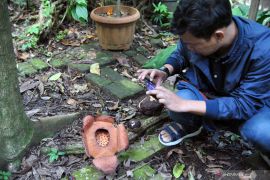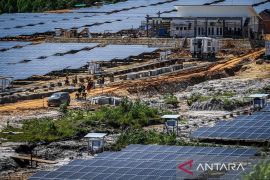Head of the nuclear research organization (ORTN) of BRIN, Rohadi Awaludin, stated that the collaboration results in significant impacts for both parties involved, such as in terms of an improvement in team capacity, progress in research, as well as HTGR tech in Indonesia.
"Research and development of HTGR technology have been pursued by BRIN researchers in the center for nuclear technology research (PRTRN) and center for research for nuclear fuel recycle and radioactive waste (PRTDBBNLR)," he noted in a statement received here on Thursday.
Awaludin expects that the two units could optimize collaboration with the university, so they could improve their human resources' capabilities.
"This will foster the spirits of young researchers of ORTN - BRIN," he affirmed.
BRIN and Tsinghua University hosted a workshop on May 2, 2023, in Tangerang, which brought up the theme of "Advancements in HTGR Technology: Insight into Reactor Design and Fuel based on Lesson Learned from HTR-PM 210 MW."
The two entities also conducted a meeting and recorded the minutes of the meeting, which resulted in a review of the collaboration that had been pursued as well as preparation for future collaboration on the "Joint Laboratory on HTGR" initiative by China and Indonesia.
There will be another workshop in June in Tangerang in which they will meet and discuss in detail about their plans on collaboration.
HTGR is one type of fourth-generation nuclear reactor that boasts myriad advantages as compared to its predecessor. Some of the advantages include better safety as well as generated heat that can be utilized to produce hydrogen gas.
Professor of Tsinghua University's Institute of Nuclear and new Energy Technology, Sun Jun, stated that China is currently aiming for dual carbon goals wherein they aim to reduce carbon emissions by 2030 and achieve carbon neutrality in 2060.
"The role of the HTGR reactor is pretty significant in China, including as an energy producer along with the PWR reactor. Moreover, it also generates steam and produces hydrogen," he elaborated.
He remarked that the HTGR being developed features inert helium cooling technology, graphite moderator, and unique TRISO fuel.
"We use some kernels in the middle, and we are also able to code each different layer with higher temperature and durable material. Moreover, we also use this particle in many forms of fuels," Jun stated.
He said that two departments in Tsinghua University -- Engineering Physics and Institute of Nuclear and new Energy Technology -- fall under the nuclear education's purview.
He expected that the collaboration between BRIN and Tsinghua University could benefit both of them.
"I hope (the representative) from BRIN can visit INET, and we can discuss about future plans," he stated.
Related news: BRIN mulls radioactive waste disposal facility
Related news: ASEAN invites nuclear-weapon states to sign SEANWFZ Treaty
Related news: Govt targets to build nuclear power plant in 2039: Bapeten
Translator: Mecca Yumna
Editor: Sri Haryati
Copyright © ANTARA 2023












